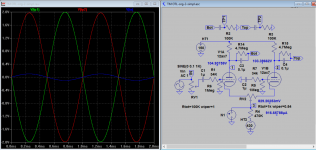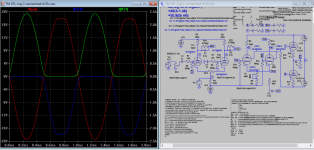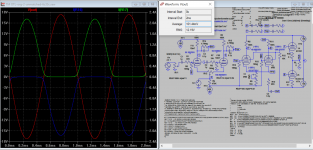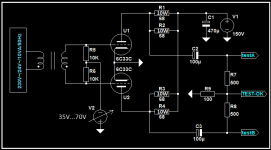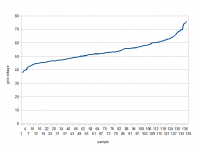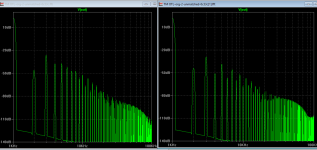Thanks again.
As I am still working on my banch at the ccs, I wander if you can simulate the output sine wave halves of the ecc83 at UP and BOT points (after R14/C3 and R15/C4) then I shall pick-up the real half waves, to have an ideea.
Please check R11 on your sim, has to be on V5a/V6c not grunded.
Thanks again.
As I am still working on my banch at the ccs, I wander if you can simulate the output sine wave halves of the ecc83 at UP and BOT points (after R14/C3 and R15/C4) then I shall pick-up the real half waves, to have an ideea.
No problem, see attached.
Attachments
-
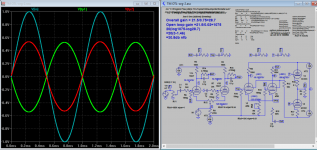 TM OTL -orginal LTP-1 Test Points -2.png360.4 KB · Views: 226
TM OTL -orginal LTP-1 Test Points -2.png360.4 KB · Views: 226 -
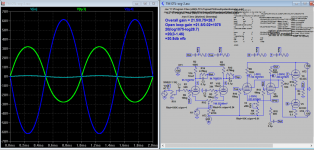 TM OTL -orginal LTP-2 Test Points -1.png380 KB · Views: 215
TM OTL -orginal LTP-2 Test Points -1.png380 KB · Views: 215 -
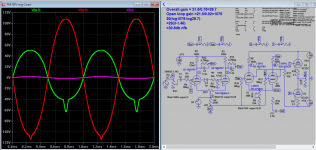 TM OTL -orginal LTP-2 Test Points -2.png334 KB · Views: 211
TM OTL -orginal LTP-2 Test Points -2.png334 KB · Views: 211 -
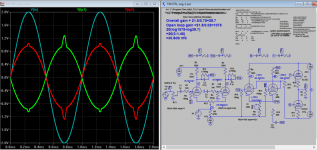 TM OTL -orginal LTP-1 Test Points -1.png311.4 KB · Views: 201
TM OTL -orginal LTP-1 Test Points -1.png311.4 KB · Views: 201 -
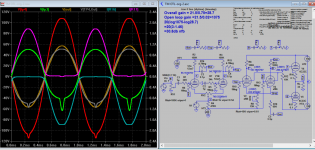 TM OTL -orginal LTP-2 Test Points -3.png403.5 KB · Views: 206
TM OTL -orginal LTP-2 Test Points -3.png403.5 KB · Views: 206
Last edited:
No problem, see attached.
Maybe you meant to spilt sch into half and sim each half without gNFB? BRB.
Maybe you meant to spilt sch into half and sim each half without gNFB? BRB.
I'd like to check only the fist stage the LTP without driver ef86 and power stage 6c33c
I'd like to check only the fist stage the LTP without driver ef86 and power stage 6c33c
ok.
Attachments
Verry nice, I hoppe my measurements to be like this, we shall see. Thanks
Sorry to change the subject guys, but I wonder is there an absolute necessity to used matched pairs of 6C33Cs. The price difference is substantial.
Here I have 2 model of 6c33c and they are about 8% difference in gain / gm so that one will clip earlier than the other. The sim shows that all you need is to reduce the input to get it out of clipping. You'll lose some power when unmatched though (only 18W in model shown), even matched pair of the that model is still 18W. But if matched pair of the other model you get 30W. So that is 40% difference in power output (you get what you paid for
You need to bypass R1 of PSU of transformer CT to minimise DC offset during adjusting.
Attachments
Last edited:
You need to bypass R1 of PSU of transformer CT to minimise DC offset during adjusting.
Thanks for that, Koonw. Did yo mean R33 in the transformer centre tap? What application are you using to get the traces?
Last edited:
Thanks for that, Koonw. Did yo mean R33 in the transformer centre tap? What application are you using to get the traces?
Yes I meant R33. I use LTSpice. In addition you need to download tubes models, you can search bbs there are bundles and zip files so many models are download at one time.
Sorry to change the subject guys, but I wonder is there an absolute necessity to used matched pairs of 6C33Cs. The price difference is substantial.
There will be higher distortion and lower output power when not using matched pairs, 6C33C with its high transconductance has very small spacing between electrodes so naturally the parameters spread very much, it is not unusual to find a tubes that draw 200mA idle current for -45V grid voltage and another tube with -65V, to use 2 tubes with those specs in one amplifier will not get a good result. I have measured over 200 tubes and have data on each. In our amplifiers we only use close matched tubes, they give higher power and lower distortion.
There are many spice models on 6C33C but most are quite incorrect especially close to cutoff where this tube have a kink, for operating point some models are OK but not for distortion. Check the model from Excem, that is the best, it include the kink.Here I have 2 models of 6c33c and they are about 8% difference in gain / gm so that one will clip earlier than the other.
There will be higher distortion and lower output power when not using matched pairs, 6C33C with its high transconductance has very small spacing between electrodes so naturally the parameters spread very much, it is not unusual to find a tubes that draw 200mA idle current for -45V grid voltage and another tube with -65V, to use 2 tubes with those specs in one amplifier will not get a good result. I have measured over 200 tubes and have data on each. In our amplifiers we only use close matched tubes, they give higher power and lower distortion.
There are many spice models on 6C33C but most are quite incorrect especially close to cutoff where this tube have a kink, for operating point some models are OK but not for distortion. Check the model from Excem, that is the best, it include the kink.
How do you supose to match the 6c33c ? did you tried 6c336-v, are they better?
When I have started my otl project, I did not cared to much about matching and they sound good since. I've heard a lott about those tubes pros and cons, but they work better each day passing. I think more important is matching the EF86. I attach the simplest matching engine I have tried for the 6c33c.
Attachments
Last edited:
How do you supose to match the 6c33c ? did you tried 6c336-v, are they better?
All 6C33C variants spread, it is natural for a high transconductance tube. We simply measure grid voltage for our set idle current and half of that, then we pick tubes with similar grid voltages, as we have so many it is not a problem to pick 2 similar but if you buy a couple on Ebay the chance of they beeing similar is very small. I attach some measurements showing grid voltage for about 130 samples. Note! u is quite similar for almost all tubes but Gm varies, so in theory you only need to match for grid voltage at one current.
Attachments
Last edited:
There will be higher distortion and lower output power.
Just a thought. Tim Mellow measured just 0.14% distortion with no feedback. We don't know how well he matched the tubes but the normal specification for a matched pair is to within 5%. He rightly says that the total global distortion figure reduces at the same rate as the amount of negative feedback which in this case is 26 dBs. My thought is that, notwithstanding the lower output power before clipping, 26 dBs of negative feedback gives a considerable latitude to the use of unmatched output tubes. I wonder has anybody ever actually measured the distortion for unmatched output tubes.
Just a thought. Tim Mellow measured just 0.14% distortion with no feedback. We don't know how well he matched the tubes but the normal specification for a matched pair is to within 5%. He rightly says that the total global distortion figure reduces at the same rate as the amount of negative feedback which in this case is 26 dBs. My thought is that, notwithstanding the lower output power before clipping, 26 dBs of negative feedback gives a considerable latitude to the use of unmatched output tubes. I wonder has anybody ever actually measured the distortion for unmatched output tubes.
Tubetvr is right about the higher distortion of unmatched tubes. I just sim the 18W model of unmatched and matched pair, it 0.44%/0.3%, the difference mostly 2nd harmonic being higher as Tim's amp can mostly cancel out even harmonics better if they are matched. So it could sound even better due to non-cancellation? I think it's no harm to order a pair to try out.
Edit: unmatched tube FFT on the left.
Attachments
Last edited:
So it could sound even better due to non-cancellation? I think it's no harm to order a pair to try out.
That's interesting because what you are saying is the it would sound a bit "warmer" with unmatched tubes?
That's interesting because what you are saying is the it would sound a bit "warmer" with unmatched tubes?
Yes, could be much warmer, earlier I have higher gain tube on lower. Another idea is to use the higher gain tube as upper tube that makes it easier to drive, then that's a little less warmer, but still warmer.
Tubetvr is right about the higher distortion of unmatched tubes. I just sim the 18W model of unmatched and matched pair, it 0.44%/0.3%, the difference mostly 2nd harmonic being higher as Tim's amp can mostly cancel out even harmonics better if they are matched. So it could sound even better due to non-cancellation? I think it's no harm to order a pair to try out.
What output power is this? the spectrum looks like it is close to clipping, at low output power you would normally see only 2nd and 3rd dominating and all others more than 20dB lower.
Tubetvr is right about the higher distortion of unmatched tubes. I just sim the 18W model of unmatched and matched pair, it 0.44%/0.3%, the difference mostly 2nd harmonic being higher as Tim's amp can mostly cancel out even harmonics better if they are matched. So it could sound even better due to non-cancellation? I think it's no harm to order a pair to try out.
What output power is this? the spectrum looks like it is close to clipping, at low output power you would normally see only 2nd and 3rd dominating and all others more than 20dB lower.
18W, just before clipping of either tube, THD around 0.4%.
[QUOTE 18W, just before clipping of either tube, THD around 0.4%.[/QUOTE]
Please compare distortion at lower output power like 1W then if the model is reasonably correct you should see larger differences, the differences in distortion you see at clipping probably are more due to difference in output power.
Please compare distortion at lower output power like 1W then if the model is reasonably correct you should see larger differences, the differences in distortion you see at clipping probably are more due to difference in output power.
- Home
- Amplifiers
- Tubes / Valves
- New Tim Mellows OTL project
